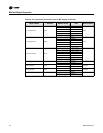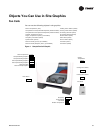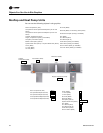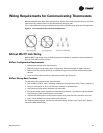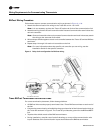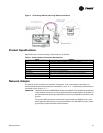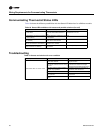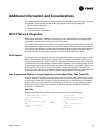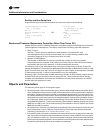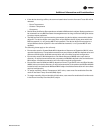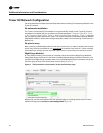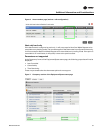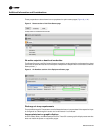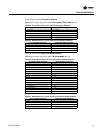
30 BAS-SVP10A-EN
Additional Information and Considerations
Rooftop and Heat Pump Units
Programs writing to the devices should have a structure similar to the following:
Retries and Timeouts (Supervisory Controllers Other Than Tracer SC)
Another thing to look for in a BACnet integration is the Device object of the Supervisory Controller
(and the Operator’s Workstation). This object contains the 2 following required properties:
• Retry Timeout
The Retry Timeout property specifies the time between re-transmissions if the
acknowledgement has not been received. When you are experiencing problems with
controllers dropping off-line, increasing this value may help.
• Number of APDU Retries;
The Number of APDU Retries property specifies the number of times unsuccessful
transmissions will be repeated. If the receiving controller has not received the transmission
successfully after this many attempts, no further attempts will be made.
For example, if one of the thermostats does not reply to a Supervisory Controller (Tracer SC)
request, and the Retry Timeout is set to 2000 msec and the Number of APDU Retries is set to 1 (still
at the Tracer SC level), then the Tracer SC will send one other request, 2 seconds later. If the MS/
TP device does not reply, it will be considered Off-line by the workstation.
So having a Retry Timeout value of 10000 msec and a Number of APDU Retries property set to 3
at the SC level may prevent device from dropping Off-line. These properties should also be
changed at the Workstation level since the workstation will likely issue requests to any MS/TP
devices when the graphics are used.
Objects and Parameters
The following items apply to all equipment types.
• Each thermostat is delivered from the factory with the default MAC address set at 254. At this
value, the BACnet communication is NOT active and the device will not participate in the token
pass either. The local LED status (located on the backside of the board) is one short flash only.
To enable the BACnet communication, set the local MAC address configuration property of the
thermostat toany valid valuefrom 0 to 127using the InstallerConfiguration Parameter menuon
the Thermostat. (Refer to the Trane Communicating Thermostats for Heat Pump Control User
Guide (BAS-SVU10A-EN), Trane Communicating Thermostats for Rooftop Control User Guide
(BAS-SVU11A-EN), or the Trane Communicating Thermostats for Fan Coil Control User Guide
(BAS-SVU12A-EN) for details.)
• All configuration objects are available and can be edited locally from the device itself using the
local configuration routine. (See the Communicating Thermostat User Guides mentioned
previously in this section or in
“Related Documents,” p. 6.)
• In its default mode of operation, the device will automatically match its baud rate to the baud
rate of the network. Automatic baud rate detection will occur when the MS/TP communication
port is initialized (on power up). If the network speed is changed, the device will keep listening
at thepreviously detectedspeed for10 minutesbeforeresuming automaticbaud ratedetection.
Re-powering the devices will force immediate auto-detection.
If Once Schedule = On then
MV11 = Occupied
End If
If Once Schedule = Off
Then
MV11 = Unoccupied
End If
OR
Do Every 5min
If Schedule = On Then
MV11= Occupied
Else
MV11 = Unoccupied
End If
End Do



